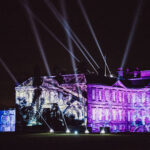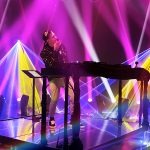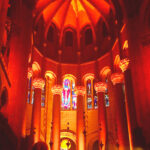Once every two years, 19 city blocks — 68 acres — of the Dallas Arts District is transformed into a visual wonderland of projected, digitized, pixilated and coherent light. The Dallas Aurora Festival 2015, billed as “an immersive free public art event of light, video and sound,” it serves as a showcase for “New Media” artists now coming of age in today’s art world. Urban structures are illuminated with high-powered digital projectors, and reflecting pools come to life in a cascading display of lasers. Coupled with the endless line of food trucks and over 60,000 attendees, this seems like a pretty good way to spend a Friday evening in Dallas, Texas.
Extra Eye Candy
Approaching downtown, I’m greeted by the familiar illuminated landmarks that make Big D so recognizable — Reunion Tower, with its spherical 259 LED node configuration towering 560 feet above the Metroplex; the 23-story Omni Hotel, boasting 2,200 digitally-controlled LED tubes at a distance of almost four miles; and Bank of America Plaza, sporting almost two miles of linear green lighting. They are all signature architectural landmarks in their own right, and all contribute to Dallas’ visual skyline. But tonight, there’s a little extra eye candy.
Started in 2011 by artists Shane Pennington and Joshua King and founding executive director of the Dallas Arts District, Veletta Forsythe Lill, what was just a neighborhood party four years ago has now turned into a gathering of artists from around the world promoting their talents and creations.
“The first year, we basically threw a party with lights, video and sound. This year, we brought in four guest curators from around the country to help us choose the artwork,” explains King. “Now, there’s an opportunity for the artists to get selected by some of these well-established curators and start building relationships with other professionals that are not just here in Texas.”
This year, Tim Goossens and Julia Kaganskiy (both from New York) along with Carson Chan (Berlin) and Aja Martin (Dallas) were the invited curators. These four people, along with Pennington and King, have the task of choosing 100 artists from around the world and giving them the opportunity to display their creations of lighting, video, projection and audio at a total of 78 installations — some as small as a ATM, some as large as a 150-foot-tall building.
“This is about using contemporary art to turn our everyday impression about our city on its head,” says King. “The Arts District is a canvas, and we’re using light and sound to transform it for a night in a way you’ll never forget.”
King also wants everyone to know that “one of Aurora’s key missions or goals is to point out to the public that art is important to our society and that artists deserve to be paid for what they do. A lot of people view artists as someone that maybe they can get to work for exposure. Aurora’s not about giving exposure, it’s about creating a livelihood.”
My first stop is at the Virgin de Guadalupe Cathedral. For some reason, a thick cloud of smoke is billowing from the door. Upon investigation, I discover that it’s an installation by artist James Clar titled “Pixelated Serenity” and involves a heavily fogged (not hazed) Catholic church and the incorporation of a series of LED lighting fixtures around the altar to create an ethereal sense of a light-filled space-less environment; reminiscent of the days of cracked oil foggers, it seems.
Coming out of the church and turning up Flora Street, I’m confronted with the largest and most obvious installation of the evening. The 151-foot-tall AT&T Preforming Arts Center, which houses the Dee and Charles Wyly Theatre, is being immersed in 3D video content titled “Sense/Coalescence” that is synced to a time track and created by conceptual design group New Your City-based 3-Search. With offices in Budapest and Berlin as well as NYC, 3-Search has been involved in some of the largest video mapping projects to date, including the 3D overlay of the Manhattan Bridge at the 2014 New York Festival of Lights.
Inside the Wyly, Portuguese artist João Beira is displaying her art incorporating motion sensors and centering on silhouetted figures heavily backlit. “Luxate” involves both digital lighting and haze and is meant to explore the perception of light and space. Across the street at the Morton H. Meyerson Symphony Center is an install by Chicago-based artist James Connolly titled “RGB.VGA.VOLT;” it involves rewiring obsolete RGB VGA monitors to create a type of video color organ.
Laser Precision
At the center of it all, located by the reflecting pond in front of the Meyerson Symphony Center, is an installation by Tom Harman of the Miami-based company LaserNet and Rick Hutton, founder and president of Dallas-based InLight Gobos. Titled “Inspired by Dali,” it features strategically positioned solid-state lasers around a 40-by-50-foot grid in a visual reference to Romanian mathematician Matila Ghyka. The artist Salavador Dali adopted Ghyka’s geometry to keep specific elements of his art in alignment during the creation process. In addition, the display becomes interactive and allows the public to interface and manipulate the lasers within the confines of the install. Every hour on the hour, everything reverts to a static “Dali” look and, from there, the attendees have a certain amount of control over where it goes.
On the outside of the grid are a number of ellipsoidal fixtures sporting high-resolution gobos created by InLight Gobos. “I first heard about Aurora back in 2011, and I’ve always wanted to be involved” says InLight’s Hutton. “In the past, it was the same weekend as the big trade show I attend every year. This year, I ask Joshua if it was alright with Tom, could I put up a gobo installation around the LaserNet perimeter.” In addition to providing gobos for all of the corporate sponsors for Aurora, InLight is showing off their expertise by utilizing a variety of “high-resolution, full-color” gobos sporting what are referred to as “organic” (think nature) patterns. While adding another layer of light to the 2,000 square-foot laser grid, parents seem to enjoy taking their kid’s picture in the middle of colorful pools of light with lasers projecting just a few feet overhead. “Dallas has been good to me, and this is one way for me to give back,” says Hutton.
Underscoring the event’s growth from a neighborhood party to a spectacle drawing big crowds and corporate sponsorships, Aurora 2015 was the first year where the AT&T Performing Arts Center played a central role. There have even been rumors that the festival might emerge as an annual event. When I asked King if there was anything definitive to announce in that regard, however, he demurred. “We’re always talking.”
Dusty Hudgins is a 37-year veteran of the entertainment lighting industry.


